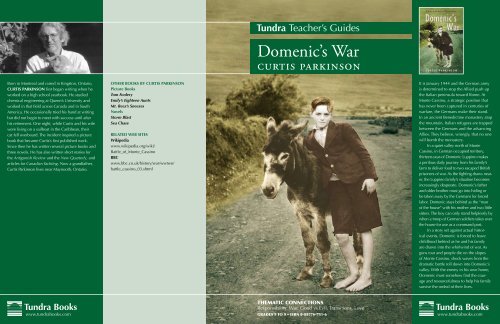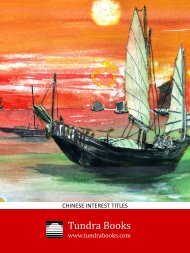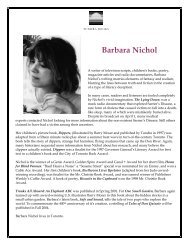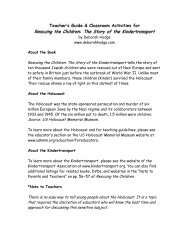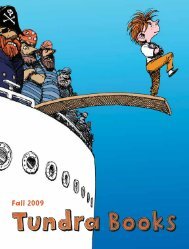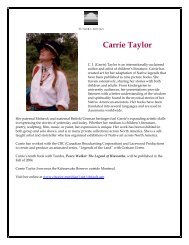Create successful ePaper yourself
Turn your PDF publications into a flip-book with our unique Google optimized e-Paper software.
<strong>Tundra</strong> Teacher’s Guides<br />
Domenic’s <strong>War</strong><br />
curtis parkinson<br />
Born in Montreal and raised in Kingston, Ontario,<br />
curtis parkinson first began writing when he<br />
worked on a high school yearbook. He studied<br />
chemical engineering at Queen’s University and<br />
worked in that field across Canada and in South<br />
America. He occasionally tried his hand at writing<br />
but did not begin to meet with success until after<br />
his retirement. One night, while Curtis and his wife<br />
were living on a sailboat in the Caribbean, their<br />
cat fell overboard. The incident inspired a picture<br />
book that became Curtis’s first published work.<br />
Since then he has written several picture books and<br />
three novels. He has also written short stories for<br />
the Antigonish Review and the New Quarterly, and<br />
articles for Canadian Yachting. Now a grandfather,<br />
Curtis Parkinson lives near Maynooth, Ontario.<br />
other books by curtis parkinson<br />
Picture <strong>Books</strong><br />
Tom Foolery<br />
Emily’s Eighteen Aunts<br />
Mr. Reez’s Sneezes<br />
Novels<br />
Storm Blast<br />
Sea Chase<br />
Related Web Sites<br />
Wikipedia<br />
www.wikipedia.org/wiki/<br />
Battle_of_Monte_Cassino<br />
BBC<br />
www.bbc.co.uk/history/war/wwtwo/<br />
battle_cassino_03.shtml<br />
It is January 1944 and the German army<br />
is determined to stop the Allied push up<br />
the Italian peninsula toward Rome. At<br />
Monte Cassino, a strategic position that<br />
has never been captured in centuries of<br />
warfare, the Germans make their stand.<br />
In an ancient Benedictine monastery atop<br />
the mountain, Italian refugees are trapped<br />
between the Germans and the advancing<br />
Allies. They believe, wrongly, that no one<br />
will bomb the monastery.<br />
In a quiet valley north of Monte<br />
Cassino, in German occupied territory,<br />
thirteen-year-of Domenic Luppino makes<br />
a perilous daily journey from his family’s<br />
farm to deliver food to two escaped British<br />
prisoners of war. As the fighting draws nearer,<br />
the Luppino family’s situation becomes<br />
increasingly desperate. Domenic’s father<br />
and older brother must go into hiding or<br />
be taken away by the Germans for forced<br />
labor. Domenic stays behind as the “man<br />
of the house” with his mother and two little<br />
sisters. The boy can only stand helplessly by<br />
when a troop of German soldiers takes over<br />
the house for use as a command post.<br />
In a story set against actual historical<br />
events, Domenic is forced to leave<br />
childhood behind as he and his family<br />
are drawn into the whirlwind of war. As<br />
guns roar and people die on the slopes<br />
of Monte Cassino, shock waves from the<br />
dramatic battle roll down into Domenic’s<br />
valley. With the enemy in his own home,<br />
Domenic must somehow find the courage<br />
and resourcefulness to help his family<br />
survive the ordeal of their lives.<br />
<strong>Tundra</strong> <strong>Books</strong><br />
www.tundrabooks.com<br />
Thematic Connections<br />
Responsibility, <strong>War</strong>, Good vs Evil, Transitions, Love<br />
Grades 5 to 9 • ISBN 0-88776-751-6<br />
<strong>Tundra</strong> <strong>Books</strong><br />
www.tundrabooks.com
Domenic’s <strong>War</strong><br />
curtis parkinson<br />
thematic Connections<br />
RESPONSIBILITY<br />
When Domenic’s father made the decision to help the British<br />
airmen, he put his own family at risk. Under the circumstances,<br />
was it the right thing to do? Was it wise of him to send<br />
a young boy like Domenic to take the airmen food?<br />
WAR<br />
<strong>War</strong> exacts a terrible price in human lives and in destruction of<br />
property. How is this shown in the experiences of (a) Domenic<br />
and (b) Antonio?<br />
GOOD VS EVIL<br />
In war, one side is seldom all good and the other side all bad.<br />
How does the story illustrate this? How did a German soldier<br />
show kindness to Sergio?<br />
TRANSITIONS<br />
Domenic’s <strong>War</strong> could be called a coming-of-age story. In what<br />
ways were Domenic and Antonio more “grown–up” by the<br />
end of the story than they were at the beginning?<br />
LOVE<br />
Even though he loses his family, Antonio clings to hope. What<br />
keeps him going?<br />
4. Monte Cassino was strategically important because of its<br />
height. Ask students why this made it a difficult objective for<br />
the Allies to capture. Other places had had strategic military<br />
importance. On a map, show students the location of Gibraltar<br />
and ask them why the British considered it a vital place to hold<br />
in the event of war.<br />
5. Two animals play key roles in this story. Ask students how<br />
the mules, Dolce and Mussolini, help the plot to unfold and<br />
come to a satisfactory conclusion.<br />
DISCUSSION QUESTIONS<br />
1. A flashback is a literary device used to tell the reader about<br />
something that happened prior to the events of the story. What<br />
flashback does Domenic have early in chapter two?<br />
2. The time and place in which the story takes place make up<br />
the setting. How does the setting for Domenic’s <strong>War</strong>, Italy during<br />
the World <strong>War</strong> II, contribute to the novel’s appeal?<br />
3. Domenic is the protagonist (main character) in this story.<br />
His antagonists (adversaries) are the German soldiers. Which<br />
German soldier is his main antagonist? Explain why.<br />
The Road to Monte Cassino<br />
After driving Axis armies out of North Africa in May of 1943,<br />
Allied commanders turned their attention to an invasion of<br />
Italy. They believed that by advancing up the Italian peninsula<br />
they could knock Italy out of the war and bring about the<br />
downfall of the fascist dictator Benito Mussolini. The capture<br />
of an Axis capital, Rome, would be of enormous symbolic<br />
importance. Hitler would be obliged to send large numbers<br />
of German troops to Italy—soldiers he might otherwise have<br />
used at the Russian front, or in France, which the Allies were<br />
preparing to invade.<br />
From North Africa the Allies captured Sicily, then crossed<br />
to the Italian mainland. However, the notion that Italy was<br />
the “soft underbelly” of Europe was soon proved false. The<br />
German army made good tactical use of Italy’s mountainous<br />
terrain. They retreated only gradually, making the Allies fight<br />
hard for every foot of ground they gained. But Allied troops<br />
from the United States, Britain, Canada, France, Poland, New<br />
Zealand, and India pushed steadily north toward Rome. Then<br />
at Monte Cassino, just south of Rome, the Germans dug in<br />
to make a stand. They deployed along a defensive position<br />
called the Gustav Line. They took full advantage of rivers and<br />
other natural obstacles, especially Monte Cassino, one of the<br />
strongest natural defensive positions in military history over<br />
which armies had fought since Roman times.<br />
in the monastery. But after the Allies had bombed it to rubble,<br />
the Germans quickly turned the ruins into a strong defensive<br />
position. The Allies’ second attack was a failure. A third attack<br />
was beaten back with heavy casualties. For the fourth attack the<br />
Allies tricked the German commander into thinking they were<br />
going to launch a sea-borne assault from the rear, causing him<br />
to move some of his troops to another location. Then they attacked<br />
Monte Cassino in full force, overwhelming the exhausted<br />
Germans by sheer firepower and weight of numbers. It was<br />
one of the bloodiest battles of the Second World <strong>War</strong>. The Allies<br />
achieved victory – at a great cost in lives—when they captured<br />
the town of Cassino and drove the Germans off the mountain.<br />
The victory was a hollow one, though. American General<br />
Mark Clark ignored orders to strike at the retreating German<br />
army and capture most of its men and equipment. He decided<br />
instead to lead his men into Rome and claim the glory<br />
of being the city’s liberator. Soldiers from half a dozen Allied<br />
nations died in the struggle for Monte Cassino, but thousands<br />
of Hitler’s troops escaped to fight in other battles.<br />
Activities and Discussion<br />
1. Using a map, explain to students how after driving the Germans<br />
out of North Africa, the Allies captured Sicily and then<br />
began the long advance through Italy. Have students locate<br />
Monte Cassino and Rome. Ask them what the Allied generals<br />
meant when they called Italy “the soft underbelly of Europe.”<br />
4. The plot of a story is the unfolding of the most important<br />
events involving the protagonist and antagonist(s). Sub-plots<br />
are smaller stories occurring within the main story. What is the<br />
plot of Domenic’s <strong>War</strong>? What is one of the sub-plots?<br />
5. Irony is a situation in which the actual result of a sequence<br />
of events is not what would normally be expected. What was<br />
ironic about the bombing of the monastery? What was ironic<br />
about the German occupation of Domenic’s home?<br />
The battle of Monte Cassino, which lasted from January 12 until<br />
May 18, 1944, was actually four battles. In the first attack, which<br />
was hampered by bad weather, the Allies suffered heavy casualties<br />
but captured the town of Anzio. It was during the second<br />
battle that the Allies made the controversial decision to bomb<br />
the ancient Benedictine monastery on the summit of Monte<br />
Cassino. They thought the Germans were using the historic site<br />
as an observation post. Actually, there were no German soldiers<br />
2. Several characters in the story make references to ordinary<br />
soldiers being killed and wounded while the senior officers are<br />
someplace relatively safe. Ask students if they think the highranking<br />
officers should have been in the front lines, or if it was<br />
right that they commanded from behind the lines. What difficulties<br />
could arise if the generals are far from the actual battle?<br />
6. The high point of a story is the climax. What is the climax<br />
of Domenic’s <strong>War</strong>?<br />
3. The bombing of the old monastery was a very controversial<br />
event. Ask students why people were critical of this action.<br />
What reason did the Allies give for their decision to do it? How<br />
did the destruction of the monastery backfire on the Allies?<br />
www.tundrabooks.com<br />
www.tundrabooks.com


